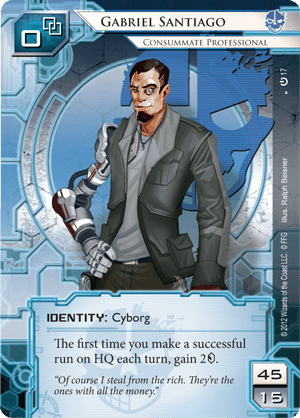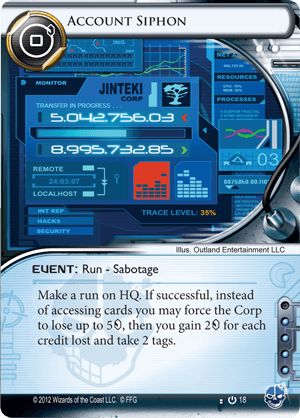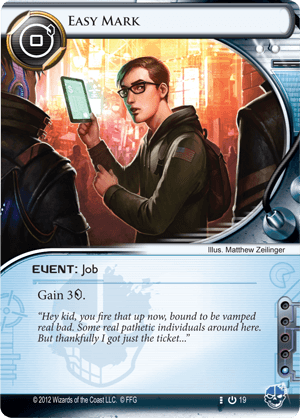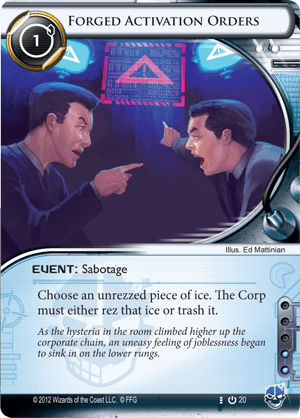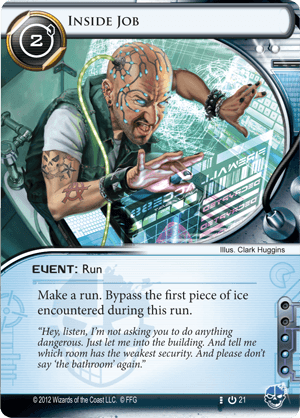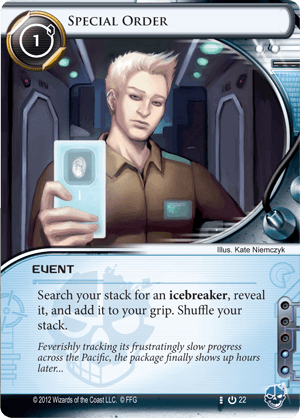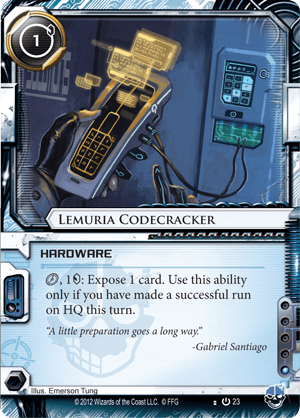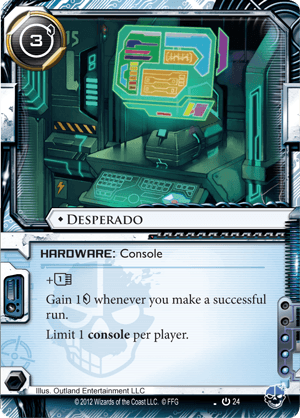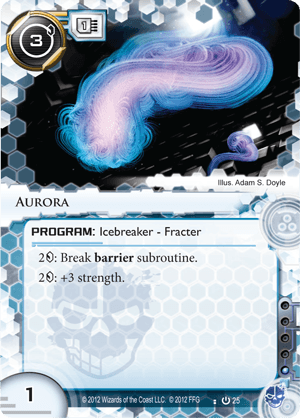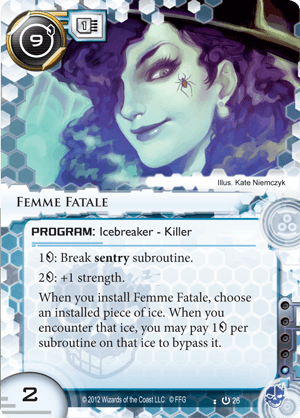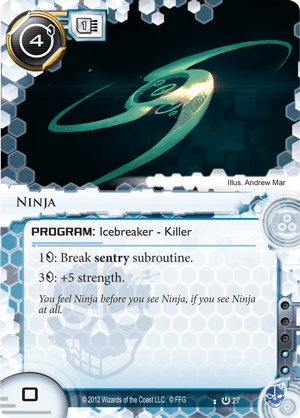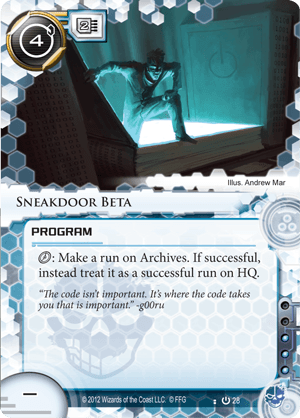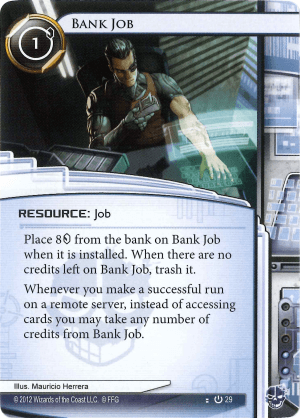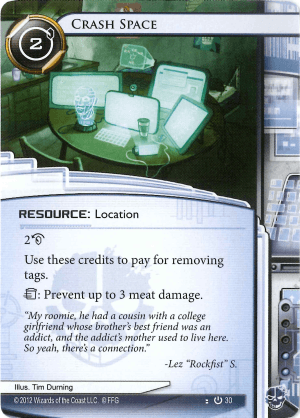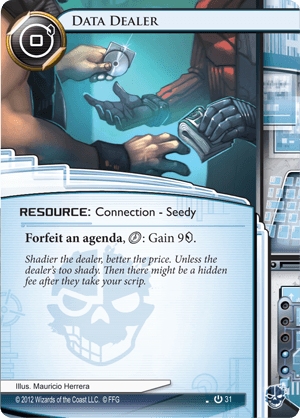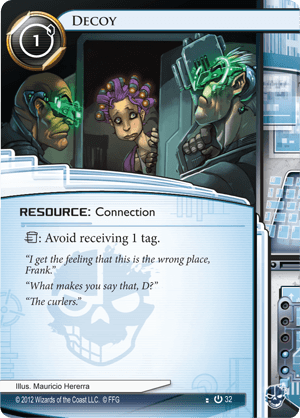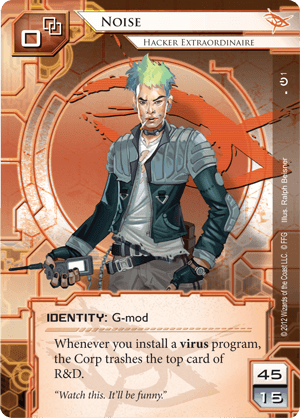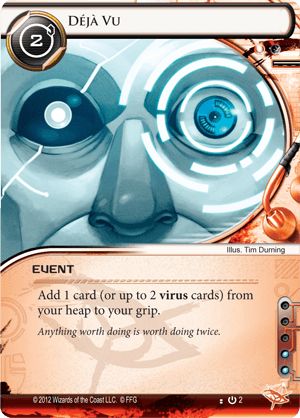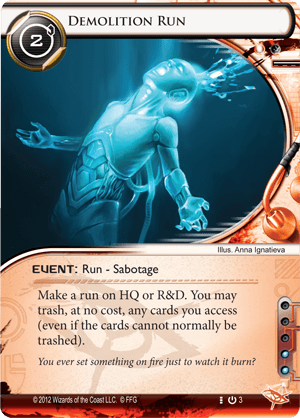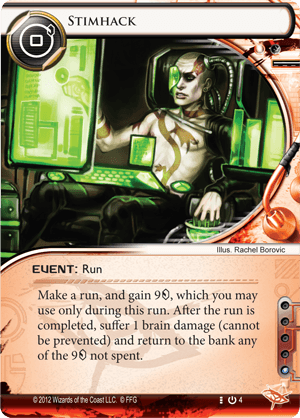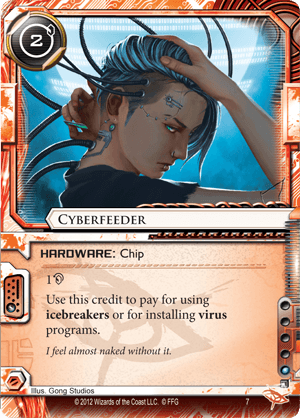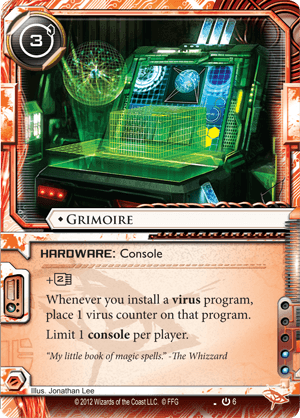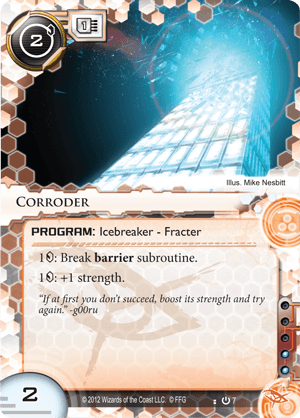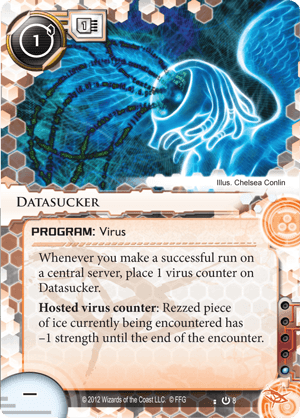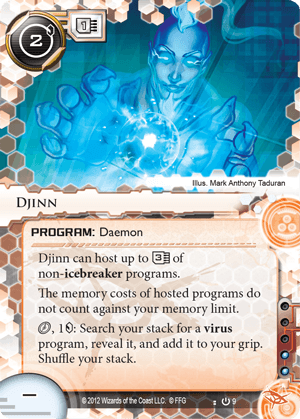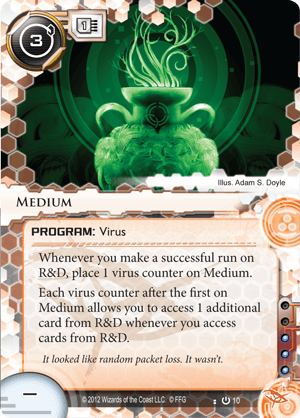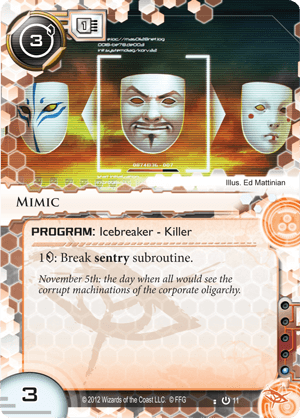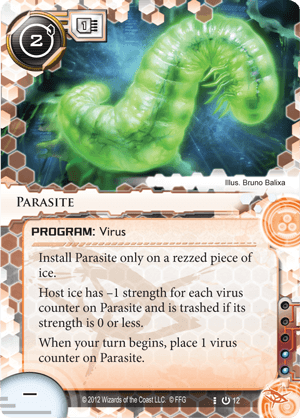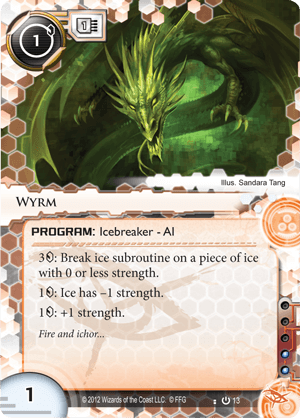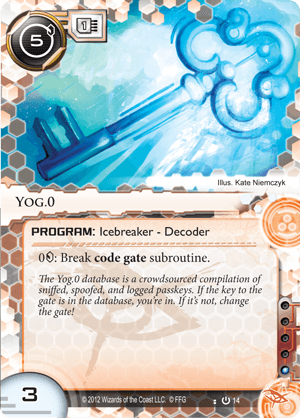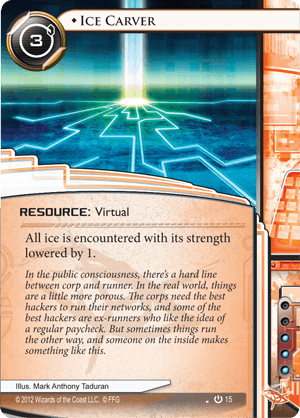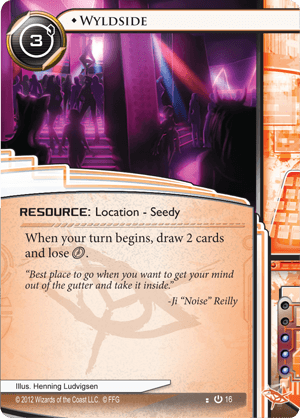Last time, we examined the Anarch cards out of the core set, and found that there's a great deal of potential. This time, we delve into the Criminal faction cards.
Gabriel Santiago: Consummate Professional
Out of the core box, Gabriel offers a fairly good idea into what the Criminal faction excels at: hitting HQ and making money. The first time each turn you make a successful run on HQ, you gain 2 credits. Note that you gain those credits as soon as the run is successful, so they are added to your credit pool before you access any cards, which can help in trashing an asset or upgrade, or paying a cost for certain agendas. Because of this effect, you'll want to have synergy with cards that help you get into HQ or reward you for getting into HQ. However, since you're playing Criminal, the corporation will know you are likely to try and take advantage of this situation, and will likely protect HQ and Archives first. Still, your advantage is in being able to attack early and force the Corporation to spend money. If you can win the economy game, then you should be able to control the flow of the game.
Trivia: Gabriel Santiago is one of the playable characters in the board game Android: Infiltration. But unless you are playing the Specialists variant, there's nothing to mechanically distinguish him from the other characters.
Pair cards: Account Siphon, Inside Job, Desperado, Sneakdoor Beta, HQ Interface, Legwork
Account Siphon
Continuing to exemplify the criminal idea. This event makes you run on HQ, and if it is successful, you can force the corporation to lose up to 5 credits, then you gain 2 credits for each credit the corporation lost, giving a potential gain of 10 credits. But if you exercise this option, you have to take 2 tags. The big thing about this is that if the corporation is low on credits, making them lose all of them can open up other possibilities of attack, since they now can't afford to rez most ice. Just be aware that the corporation does have an opportunity before the run is successful to spend their credits to rez assets and upgrades. As such, you are free to choose not to use this ability.
Trivia: Not exactly a reprint of any Netrunner CCG card, but there is a close match in Edited Shipping Manifests, which has the same effect, only you force the corporation to lose 1 credit and gain 10 credit, then take one tag.
Pair cards: Desperado, Networking, Same Old Thing, Lawyer Up, Maya
Easy Mark
This card used to be very staple economy for Criminals, or anyone who wants to spend the influence to add it. While the credit gain isn't nearly as great as other economy options, the main thing about this one is that it costs nothing to play, so if you've burned through all your credits installing cards or you had to spend it all on a run, this one will bring you back up to 3.
Trivia: We've got another reprint from Netrunner CCG here. In this case, the old card was called Livewire's Contacts.
Pair cards: Anything really. This one kind of stands on its own.
Forged Activation Orders
An amazing operation that forces the corporation to make a tough decision: do they rez a piece of ice, which may cost them credits that they need, or do they trash it, making it potentially easier for you to assault that server? Usually, either option will benefit you, unless you blindly pick a cheap piece of ice. As such, you should probably consider cards with expose effects so you can find something that you want out of the way.
Trivia: A direct reprint from Netrunner CCG this time, right down to the name and cost. Here's a link to the classic Forged Activation Orders.
Pair cards: Infiltration, Lemuria Codecracker, Satellite Uplink, Emergency Shutdown
Inside Job
Is the corporation trying to defend their agenda with just one piece of ice? Punish them for that idea with this card. Bypassing a piece means that you don't have to interact with it, which is good for getting around large ice that would otherwise be expensive to deal with. This can save you a great deal of money on a run.
Trivia: Another direct reprint from Netrunner CCG. Here's the classic Inside Job.
Pair cards: Same Old Thing, Public Terminal, Planned Assault
Special Order
Another tutor card. This one lets you take any icebreaker of your choice out of your deck and put it into your hand. This can be very helpful if the corporation is defending their servers with one type of ice, or you just need that one last icebreaker to complete your rig.
Trivia: We have a fairly close card here to a classic Netrunner CCG card. Temple Microcode Outlet lets you search your deck for any program, though. Perhaps the developers thought that was a little too powerful an effect for that cost.
Pair cards: Icebreakers, Prepaid VoicePAD
Lemuria Codecracker
This card is frequently overlooked, mostly because of the requirement built into its effect. If you have made a successful run on HQ on the same turn, you can spend a click and a credit to expose any one card. I suppose the big problem with this is the time cost, since Infiltration accomplishes the same effect for free without needing a successful run on HQ first. Still, the advantage this has over Infiltration is that it's highly reusable.
Trivia: Not quite a reprint, but the classic Netrunner CCG card SeeYa has the same effect, only without requiring a successful run on HQ. And it's a program instead of hardware.
Pair cards: Sneakdoor Beta, Feint, Blackguard
Desperado
I'm fairly certain this is supposed to be Gabriel's console, given the name. But anyway, this is the console to which all other Criminal consoles are compared. It gives you 1 extra memory, but the main effect is gaining 1 credit whenever you make a successful run. Pairing this up with other effects that trigger on successful runs can net you a great economic advantage. But this economic advantage is what ultimately led to this card being placed onto the NAPD Most Wanted List.
Pair cards: Datasucker, Dirty Laundry, John Masanori
Aurora
We come to the first of the Criminal icebreakers. The big problem with Aurora over Corroder is in the cost to break subroutines: 2 credits instead of 1. The only real advantage this has over Corroder is the slight efficiency of gaining 3 strength for 2 credits, but that can be a downside, since Corroder can start breaking strength 2 barriers without having to pumps, whereas this has to spend 2 credits before it can interact with those strength 2 barriers. I suppose the only real reason to take this is if you will be making large enough piles of cash to utilize it and you don't have the influence for Corroder.
Pair cards: E3 Feedback Implants
Femme Fatale
This lady is highly useful. While she can be used to break sentries, anything that requires pumping her strength extensively will become very expensive fast. Her true potential lies in her ability to select a piece of ice when she is installed. Whenever you encounter that piece of ice, you can bypass it by paying 1 credit for each subroutine on that piece of ice. The can let you get past an expensive piece of ice cheaply. Of course, the corporation may choose to trash that piece of ice, so the ability can be lost.
Trivia: We don't have an exact reprint here, but the Netrunner CCG card Black Widow comes fairly close. The statistics on this card are the same as Femme Fatale, but instead of being able to bypass a piece of ice, Black Window gains 5 strength during encounters with the selected piece of ice. Of course, if the piece of ice isn't a sentry, that doesn't help you much.
Pair cards: Test Run, Scavenge
Ninja
Between Femme Fatale and Ninja, it becomes apparent that the Criminal faction is designed to deal with sentries. Ninja is very efficient, gaining 5 strength for only 3 credits. Plus, it breaks subroutines for only 1 credit. The downside to this is that many sentries will end up costing you 4 or 5 credits due to this.
Pair cards: Datasucker, Ice Carver, The Personal Touch, Dinosaurus
Sneakdoor Beta
This can really catch your opponents off guard. Installing this program forces your opponent to defend Archives, since now you can turn successful runs on Archives into successful runs on HQ. The only downside is that this program takes up 2 memory, so you'll want your console or some memory chips installed.
Trivia: It turns out this is a reprint. From the Netrunner CCG, we have Shredder Uplink Protocol, which has the same install cost, memory requirement, and effect.
Pair with: HQ Interface, Emergency Shutdown
Bank Job
If the corporations you are playing against are leaving their assets unprotected, you can make a lot of money off of them. At the cost of 1 credit, you could gain 8 credits on a successful run against a remote server. Of course, nothing is forcing you to take all of those credits off of this card.
Pair cards: Aesop's Pawnshop
Crash Space
This is actually fairly useful. If you know you are going to be taking tags, the having 2 recurring credits to pay for removing them is highly useful. Plus, this can be trashed to prevent 3 meat damage, which means that if the corporation is trying to kill you that way, the may be force to deal with this card first.
Trivia: In the Netrunner CCG, Crash Space is also a resource, but it has a much different effect. It gives you a credit at the start of each turn, but all trace attempts by the corporation automatically succeed and give you a tag in addition to other effects. Plus, if the classic Crash Space leaves play, you lose 2 credits.
Pair cards: Account Siphon, Vamp, Code Siphon
Data Dealer
At first glance, the idea of giving up an agenda seems like a bad idea. Still, this is one of the largest burst economy effects in the game, and the most efficient per click. Plus, it lets you get rid of the negative effects of Shi.Kyū and News Team while making a massive profit.
Trivia: We have an almost reprint here. The classic Netrunner CCG card Databroker is almost identical to this one, except that you forfeit an agenda point to gain 10 credits. I guess it was just too much hassle to force players to track agenda points separately from agendas scored or stolen.
Pair cards: Notoriety, Fan Site
Decoy
This is pretty explanatory. For 1 credit, you get a card that allows you to avoid 1 tag once. You may be wondering, "Why not just remove the tag afterwards?" Well, there are cards that trigger off of you receiving a tag (Rachel Beckman), or having a tag at a specific time (Dedicated Response Team), which can cause problems. As such, avoiding the tag altogether may be a better option in those cases.
Pair cards: Calling in Favors, Armand "Geist" Walker: Tech Lord
Well, that does it for the Criminal Core Set cards. Next time, we'll look over the Shaper Core Set cards.
Friday, July 8, 2016
Wednesday, July 6, 2016
Card Analysis - Core Anarch
When I first started up this blog, one of the possible article types I had hinted at was analysis of cards from the various sets. Almost immediately after that post, I found the blog Wyldside, which was dedicated to the exact same thing. As such, I felt I didn't really need to do the analysis. However, it has been almost a year now since Wyldside was last updated, having stopped partway through the Genesis cycle. So, while I know it has already been done to death to review individual cards, I figure I may as well give my own take on the idea.
But there will be some differences between me and other reviewers. I will not be ranking or scoring cards. Almost all rankings of cards agree on which cards are good and which are bad, taking into consideration either the card in a vacuum or the card in combination with other cards. I'm of the opinion that every card has possibilities, and to ignore those possibilities just because the card does little on its own is to do a disservice to the design. As such, each card I go over will include a list of recommendations of other cards to pair with it in order to improve the card's potential.
That being said, let's start with the beginning: the Core Set Anarch cards.
Noise: Hacker Extraordinaire
Noise is the archetype when you consider the Anarch faction in Netrunner. His goal is to destroy the corporation, one card at a time. He does this by launching a swarm of viruses, which eat away at the corporation's research computers.
While initially Noise was considered one of the weakest runners, he has developed over time into becoming one of the most powerful. Every time a new virus is released, his toolset improves. Plus, he has in-faction access to a console designed specifically to work with viruses. But since we'll be getting to that console later in this article, we'll discuss that more then.
Trivia: Noise is one of the potential murder suspects in the Android board game. Is he a cold-blooded killer, or did he hire the person who did the deed, or is he being framed?
Pair cards: Viruses, Grimoire, Keyhole
Déjà Vu
It's interesting. This is the first form of recursion in the game. While there are now forms of recursion that grant you your entire deck back, or let you install cards from your discard pile, this one is still rather good. For 2 credits, you can get any one card or two virus cards from your discard pile into your hand. Of course, this majorly benefits Noise, but can be used with anybody who utilizes viruses.
Pair cards: Noise, Viruses
Demolition Run
Again, the idea of Anarch being about destroying the corporation is reinforced here. You make a run where you can trash any cards you access, even if the can't normally be trashed, for free. Of course, to get the most use out of this, you'll want to be able to access as many cards as possible during this one run.
Pair cards: Medium, Nerve Agent, HQ Interface, R&D Interface
Stimhack
This card works very well as a surprise. The corporation may think that their server is unassailable due to their large amount of ice, but the 9 temporary credits gives you a great jump in cash. The big downside is the one unpreventable brain damage at the end of the run. Plus, any of those 9 credits you don't use are lost.
Trivia: We have here one of the first reprints of cards from the Netrunner CCG. Originally, this card was called Lucidrine™ Booster Drug.
Pair cards: Personal Workshop
Cyberfeeder
The big thing about recurring credits is that you receive them at the start of your turn. As such, the more recurring credits you spend, the more credits you are keeping in your credit pool, which means those credits can be used for other costs, such as paying for icebreakers, or trashing cards, or boosting link, or whatever you need. In this case, Cyberfeeder does double duty. Its one credit can be used to either pay for installing a virus card or for using icebreakers. And remember, that credit doesn't have to be spent for pumping the icebreaker or breaking a subroutine. It can be used with any paid ability or effect, such as the ability to bypass ice with Femme Fatale or placing virus counters on Darwin.
Pair cards: Viruses, icebreakers
Grimoire
As I alluded to earlier, this is the console that Noise will almost always be running. In fact, this console can work well for anybody. For 3 credits, you gain +2 Memory Units, and whenever you install a virus program, you place a counter onto that program. With Medium or Nerve Agent, it means that you can access an extra card on the first run after installing it. With Imp, you gain the potential to trash an additional card. With Cache you gain an extra credit.
The only problem I have with this card is that the flavor text states that the console belongs to Whizzard, and yet it works much better for Noise.
Pair cards: Noise, viruses, anyone who needs extra MU
Corroder
Quite possibly the standard by which all Fracter icebreakers are judged by. It's cheap to install, and it has the highest efficiency, costing only 1 credit to increase strength or break a subroutine. The trade off here is that it starts with only 2 strength, but most of the common barrier ice you will see will be within easy reach of this program.
Trivia: We have a potential reprint here. Hammer from Netrunner CCG has the exact same statisticts as Corroder, but since the Noisy mechanic isn't in this version, it's not an exact copy.
Pair cards: Datasucker, Cyberfeeder, Dyson Fractal Generator
Datasucker
Again, this also works to define the Anarch idea. This program builds up counters each time you make a successful run on a central server (R&D, HQ, or Archives,) and each counter can be spent during an encounter with a piece of ice to lower the strength of that ice by 1 for the remainder of the encounter. This can be used as an alternate economy, letting you save your credits, or it can be used for one of the most fearsome options Anarchs have in their arsenal: ice destruction.
Pair cards: Grimoire, Parasite
Djinn
The very first Daemon in the game. In addition to giving you extra space for storing programs that aren't icebreakers, Djinn allows you to search your deck (sometimes called tutoring, from a series of cards in Magic: the Gathering that let you search your deck) for a virus card, and then add it to your hand. This makes Djinn a good place to store your viruses, but take care to protect it, as if it is trashed, all the hosted programs are trashed as well.
Pair cards: Noise, viruses, Cyberfeeder
Medium
The first option for multi-access in Runner. Each counter on it after the first allows you to access an additional card from R&D when you access R&D. Also, you place a counter on it when you make a
successful run on R&D, so the more times you make successful runs on R&D, the more cards you can see. Plus, the ability is optional, so you are not forced to look at additional cards while using this, in case you fear that there may be a Snare! waiting for you.
Oh, and if you have multiple Mediums installed simultaneously, then both apply, If they both have 2 counters on each of them, you can access up to 3 cards.
Trivia: Another reprint from Netrunner CCG. This one was originally called Highlighter.
Pair cards: Noise, Grimoire, Cyberfeeder
Mimic
Kind of another staple of Anarch: the fixed strength breaker. For 3 credits, you can break any sentry ice that has strength of 3 or lower. But with Datasucker in play, you could break sentries with even higher strength than that.
Trivia: Another reprint, sort of. The Netrunner CCG card Codeslinger has the exact same statistics, except for its 7 credit install cost. Aren't you glad Mimic is so much cheaper? Also, the flavor text is a reference to November 5th, Guy Fawkes' Day, where a group conspired to blow up the British Parliment. The artwork references the masks the conspirators wore, which have since been adopted by hacker group Anonymous.
Pair cards: Datasucker, Parasite, The Personal Touch, Dinosaurus, Net-Ready Eyes
Parasite
Once again, reinforcing the Anarch idea of destruction. This card is attached to a piece of rezzed ice and slowly drains the strength of that ice. And if that piece of ice is reduced to 0 strength, then Parasite trashes it. Just remember that since it has to be hosted onto a piece of ice, you can't host it on your Djinn or other Daemon at the same time. The sheer destructive power of this card combined with the ease of recursion now available are what resulted in this card being put onto the NAPD Most Wanted List, effectively making it an additional influence out of faction, or 1 influence in Anarch.
Pair cards: Noise, Déjà Vu, Datasucker, Clone Chip
Wyrm
You don't actually see Wyrm that much. While it is cheap to install and its status as an AI icebreaker means it can deal with anything, the main problem is in its costs to use. First, in order to interact with a piece of ice, you have to pump Wyrm's strength up to match that piece of ice. Then, you have to use Wyrm to reduced that piece of ice down to 0 strength. Finally, you can now spend 3 credits per subroutine you wish to break on that piece of ice. As such, Wyrm is more often used in conjunction with Parasite for ice destruction.
Pair cards: Datasucker, Parasite, Cyberfeeder
Yog.0
Another fixed strength icebreaker for Anarchs, this time breaking code gates. Alone, this lets you break any 3 strength or lower code gate for free, making a lot of code gates useless. But combined with reducing ice strength or boosting this cards strength and you can make even more code gates less than stellar. The sheer power of this ability led to this card being placed onto the NAPD Most Wanted List.
Trivia: Another direct reprint from Netrunner CCG, where it was originally called Tinweasel. Also, a possible H.P. Lovecraft reference to Yog-Sothoth, known as the keeper of gates.
Pair cards: Datasucker, Dinosaurus, Net-Ready Eyes
Ice Carver
Again, reinforcing the archetype of weakening and potentially destroying ice. For 3 credits, all ice is encounted with strength lowered by 1. This means that Parasite needs 1 fewer counter to destroy a piece of ice. Plus, it improves the utility of the fixed strength breaker suite. Just be aware that this resource is unique, so you can't have more than one copy installed.
Trivia: Not exactly a direct reprint from Netrunner CCG, although that game does have a program called Clown with the exact same effect. But Clown isn't unique, so you could have multiple copies of it installed.
Pairs with: Parasite, fixed-strength icebreakers
Wyldside
The main thing about this card is click efficiency. The more you can get out of each click, the more potential advantage you can get. Normally, in order to draw two cards, you would have to spend two clicks. But with Wyldside, at the cost of losing a click, you get to draw two cards at the start of your turn. If you can keep drawing cards, that can turn into a massive advantage.
Update: As of July 12, 2016, Wyldside is now on the NAPD Most Wanted List. So if you're an Anarch player, keeping this in will mean having to make hard choices on your influence.
Trivia: A nightclub on the moon catering to genetically modified humanoids with animal features. Also, where the aforementioned blog derived its name from.
Pair cards: Adjusted Chronotype, Faust
And that does it for the Core Set Anarch cards. Next time, we'll examine the Core Set Criminal cards.
But there will be some differences between me and other reviewers. I will not be ranking or scoring cards. Almost all rankings of cards agree on which cards are good and which are bad, taking into consideration either the card in a vacuum or the card in combination with other cards. I'm of the opinion that every card has possibilities, and to ignore those possibilities just because the card does little on its own is to do a disservice to the design. As such, each card I go over will include a list of recommendations of other cards to pair with it in order to improve the card's potential.
That being said, let's start with the beginning: the Core Set Anarch cards.
Noise: Hacker Extraordinaire
Noise is the archetype when you consider the Anarch faction in Netrunner. His goal is to destroy the corporation, one card at a time. He does this by launching a swarm of viruses, which eat away at the corporation's research computers.
While initially Noise was considered one of the weakest runners, he has developed over time into becoming one of the most powerful. Every time a new virus is released, his toolset improves. Plus, he has in-faction access to a console designed specifically to work with viruses. But since we'll be getting to that console later in this article, we'll discuss that more then.
Trivia: Noise is one of the potential murder suspects in the Android board game. Is he a cold-blooded killer, or did he hire the person who did the deed, or is he being framed?
Pair cards: Viruses, Grimoire, Keyhole
Déjà Vu
It's interesting. This is the first form of recursion in the game. While there are now forms of recursion that grant you your entire deck back, or let you install cards from your discard pile, this one is still rather good. For 2 credits, you can get any one card or two virus cards from your discard pile into your hand. Of course, this majorly benefits Noise, but can be used with anybody who utilizes viruses.
Pair cards: Noise, Viruses
Demolition Run
Again, the idea of Anarch being about destroying the corporation is reinforced here. You make a run where you can trash any cards you access, even if the can't normally be trashed, for free. Of course, to get the most use out of this, you'll want to be able to access as many cards as possible during this one run.
Pair cards: Medium, Nerve Agent, HQ Interface, R&D Interface
Stimhack
This card works very well as a surprise. The corporation may think that their server is unassailable due to their large amount of ice, but the 9 temporary credits gives you a great jump in cash. The big downside is the one unpreventable brain damage at the end of the run. Plus, any of those 9 credits you don't use are lost.
Trivia: We have here one of the first reprints of cards from the Netrunner CCG. Originally, this card was called Lucidrine™ Booster Drug.
Pair cards: Personal Workshop
Cyberfeeder
The big thing about recurring credits is that you receive them at the start of your turn. As such, the more recurring credits you spend, the more credits you are keeping in your credit pool, which means those credits can be used for other costs, such as paying for icebreakers, or trashing cards, or boosting link, or whatever you need. In this case, Cyberfeeder does double duty. Its one credit can be used to either pay for installing a virus card or for using icebreakers. And remember, that credit doesn't have to be spent for pumping the icebreaker or breaking a subroutine. It can be used with any paid ability or effect, such as the ability to bypass ice with Femme Fatale or placing virus counters on Darwin.
Pair cards: Viruses, icebreakers
Grimoire
As I alluded to earlier, this is the console that Noise will almost always be running. In fact, this console can work well for anybody. For 3 credits, you gain +2 Memory Units, and whenever you install a virus program, you place a counter onto that program. With Medium or Nerve Agent, it means that you can access an extra card on the first run after installing it. With Imp, you gain the potential to trash an additional card. With Cache you gain an extra credit.
The only problem I have with this card is that the flavor text states that the console belongs to Whizzard, and yet it works much better for Noise.
Pair cards: Noise, viruses, anyone who needs extra MU
Corroder
Quite possibly the standard by which all Fracter icebreakers are judged by. It's cheap to install, and it has the highest efficiency, costing only 1 credit to increase strength or break a subroutine. The trade off here is that it starts with only 2 strength, but most of the common barrier ice you will see will be within easy reach of this program.
Trivia: We have a potential reprint here. Hammer from Netrunner CCG has the exact same statisticts as Corroder, but since the Noisy mechanic isn't in this version, it's not an exact copy.
Pair cards: Datasucker, Cyberfeeder, Dyson Fractal Generator
Datasucker
Again, this also works to define the Anarch idea. This program builds up counters each time you make a successful run on a central server (R&D, HQ, or Archives,) and each counter can be spent during an encounter with a piece of ice to lower the strength of that ice by 1 for the remainder of the encounter. This can be used as an alternate economy, letting you save your credits, or it can be used for one of the most fearsome options Anarchs have in their arsenal: ice destruction.
Pair cards: Grimoire, Parasite
Djinn
The very first Daemon in the game. In addition to giving you extra space for storing programs that aren't icebreakers, Djinn allows you to search your deck (sometimes called tutoring, from a series of cards in Magic: the Gathering that let you search your deck) for a virus card, and then add it to your hand. This makes Djinn a good place to store your viruses, but take care to protect it, as if it is trashed, all the hosted programs are trashed as well.
Pair cards: Noise, viruses, Cyberfeeder
Medium
The first option for multi-access in Runner. Each counter on it after the first allows you to access an additional card from R&D when you access R&D. Also, you place a counter on it when you make a
successful run on R&D, so the more times you make successful runs on R&D, the more cards you can see. Plus, the ability is optional, so you are not forced to look at additional cards while using this, in case you fear that there may be a Snare! waiting for you.
Oh, and if you have multiple Mediums installed simultaneously, then both apply, If they both have 2 counters on each of them, you can access up to 3 cards.
Trivia: Another reprint from Netrunner CCG. This one was originally called Highlighter.
Pair cards: Noise, Grimoire, Cyberfeeder
Mimic
Kind of another staple of Anarch: the fixed strength breaker. For 3 credits, you can break any sentry ice that has strength of 3 or lower. But with Datasucker in play, you could break sentries with even higher strength than that.
Trivia: Another reprint, sort of. The Netrunner CCG card Codeslinger has the exact same statistics, except for its 7 credit install cost. Aren't you glad Mimic is so much cheaper? Also, the flavor text is a reference to November 5th, Guy Fawkes' Day, where a group conspired to blow up the British Parliment. The artwork references the masks the conspirators wore, which have since been adopted by hacker group Anonymous.
Pair cards: Datasucker, Parasite, The Personal Touch, Dinosaurus, Net-Ready Eyes
Parasite
Once again, reinforcing the Anarch idea of destruction. This card is attached to a piece of rezzed ice and slowly drains the strength of that ice. And if that piece of ice is reduced to 0 strength, then Parasite trashes it. Just remember that since it has to be hosted onto a piece of ice, you can't host it on your Djinn or other Daemon at the same time. The sheer destructive power of this card combined with the ease of recursion now available are what resulted in this card being put onto the NAPD Most Wanted List, effectively making it an additional influence out of faction, or 1 influence in Anarch.
Pair cards: Noise, Déjà Vu, Datasucker, Clone Chip
Wyrm
You don't actually see Wyrm that much. While it is cheap to install and its status as an AI icebreaker means it can deal with anything, the main problem is in its costs to use. First, in order to interact with a piece of ice, you have to pump Wyrm's strength up to match that piece of ice. Then, you have to use Wyrm to reduced that piece of ice down to 0 strength. Finally, you can now spend 3 credits per subroutine you wish to break on that piece of ice. As such, Wyrm is more often used in conjunction with Parasite for ice destruction.
Pair cards: Datasucker, Parasite, Cyberfeeder
Yog.0
Another fixed strength icebreaker for Anarchs, this time breaking code gates. Alone, this lets you break any 3 strength or lower code gate for free, making a lot of code gates useless. But combined with reducing ice strength or boosting this cards strength and you can make even more code gates less than stellar. The sheer power of this ability led to this card being placed onto the NAPD Most Wanted List.
Trivia: Another direct reprint from Netrunner CCG, where it was originally called Tinweasel. Also, a possible H.P. Lovecraft reference to Yog-Sothoth, known as the keeper of gates.
Pair cards: Datasucker, Dinosaurus, Net-Ready Eyes
Ice Carver
Again, reinforcing the archetype of weakening and potentially destroying ice. For 3 credits, all ice is encounted with strength lowered by 1. This means that Parasite needs 1 fewer counter to destroy a piece of ice. Plus, it improves the utility of the fixed strength breaker suite. Just be aware that this resource is unique, so you can't have more than one copy installed.
Trivia: Not exactly a direct reprint from Netrunner CCG, although that game does have a program called Clown with the exact same effect. But Clown isn't unique, so you could have multiple copies of it installed.
Pairs with: Parasite, fixed-strength icebreakers
Wyldside
The main thing about this card is click efficiency. The more you can get out of each click, the more potential advantage you can get. Normally, in order to draw two cards, you would have to spend two clicks. But with Wyldside, at the cost of losing a click, you get to draw two cards at the start of your turn. If you can keep drawing cards, that can turn into a massive advantage.
Update: As of July 12, 2016, Wyldside is now on the NAPD Most Wanted List. So if you're an Anarch player, keeping this in will mean having to make hard choices on your influence.
Trivia: A nightclub on the moon catering to genetically modified humanoids with animal features. Also, where the aforementioned blog derived its name from.
Pair cards: Adjusted Chronotype, Faust
And that does it for the Core Set Anarch cards. Next time, we'll examine the Core Set Criminal cards.
Subscribe to:
Comments (Atom)
